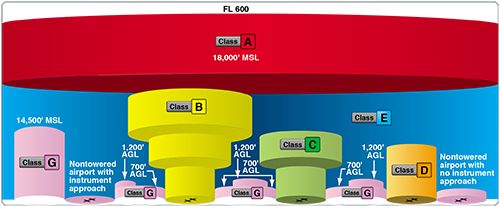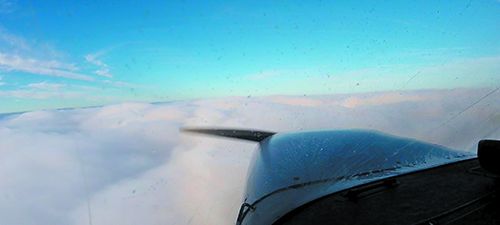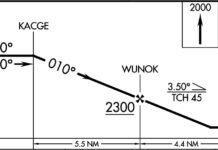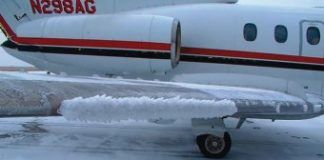The first thing that might be on your mind is; “Aren’t there fewer rules if you are IFR?” Well, kind of. The main example is if you are IFR, you need not worry about weather requirements for entering certain airspace. An IFR clearance in itself provides separation from other aircraft and obstacle clearance in all but class G airspace, hence the phraseology, “upon entering controlled airspace…” Actual requirements for entering airspace vary and you can better prepare yourself based on what controllers might or might not say or do. How do the normal airspace requirements vary if you are on an IFR flight plan?
VFR vs IFR
We’ve all seen the charts that explain the requirements for flying through certain airspace, and controllers even use them at times. The main thing that could stop a VFR pilot from entering certain airspace is weather. With the exception of military special-use airspace (SUA), there is no VFR stuff going on in Class A airspace. Weather, airplane equipment, and pilot qualifications aside, in Class B you need prior two-way communications and a clearance. In Class C and D you need prior two-way communications; in Class E you only need prior communications if on an IFR flight plan. Ok great! But Ifile IFR 95 percent of the time … how does this apply to me?
Breaking it down again in an IFR setting, you don’t need to hear the words “Cleared into Class Bravo” if you are on an IFR flight plan. If your existing clearance or vector takes you through the airspace, that’s implied permission. Plus, you already have your two-way radio communications. Your existing IFR clearance is basically an automatic clearance through the airspace. Class B is “Busy” due to volume, busy enough to give the VFR guys vectors and hard altitudes as well. Gotta keep ’em separated!
In Class C and D, again no additional clearance is required when flying IFR. Class C is fundamentally a small B but not as busy, and a Class D is typically a four NM circle around the field. What about that one time when you are trying to reach ATC and you can hear them but they can’t hear you? Logic would suggest that you land as soon as practical instead of continue into Class B, C, or D airports. But wait. You are IFR and in IMC. Assuming everything is okay minus the radios, ATC expects exactly what your first CFII taught you—to continue on assigned route and altitude if possible, or if radar vectored, a direct route from when you lost comms to the next fix, route, or airway specified.
But what if you do have functioning radios and limited or no contact with ATC? Do the same actions apply? Recent arguments in certain online forums suggest that if you cannot establish contact with a Class C or D tower, while IFR, that you should still follow the “two-way radio” rule and remain outside the airspace. This is incorrect. How are you going to vector yourself in IMC with lost comms? Could you do it? In an emergency, yes. Is it wise? Nope.
The example was an event in Class D airspace, when the tower controller was so busy with several VFR inbounds that he had no chance to respond to the IFR jet inbound. By the time he could speak to the jet, it was already on short final of the primary runway with an airplane still on the runway. The IFR jet was sent around.
I researched this situation and it comes down to ATC priorities. IFR aircraft have the priority, and in the limited case, the controller wasn’t wrong, he was just way too busy. Unless you have greater reason to deviate from that flight plan, such as an emergency, you fly your route, all the way to the numbers.
At the airport where I work, there are several non-towered fields nearby. A few of those require the IFR airplane talking to Approach to transition my Class D, but I seldom speak to them because Approach generally holds them until the last second. One day, there was an event with a pilot who didn’t cancel. While I’m working my own traffic, I do watch the transitions as they come close to my extended runway centerline at a certain point, but I don’t think much about it after that. Our traffic was one after another with only a few minutes between arrivals. A few minutes before the event happened, the weather dropped to IFR, about 800 overcast at my field, so I’m guessing it was similar at the non-controlled field.
That field does have an RNAV approach to both runway ends. Shortly after, there was one arrival that I couldn’t help but watch. He nailed the lateral guidance, but the altitude was erratic. Too high, too low, LA (Low Altitude) alert on my screen, too high again, and another LA alert. I just watched the target as I had no traffic at the time. So, a few minutes passed by and he disappeared of the screen at the landing airport. I assume, “Okay it’s all good—they landed safe…” About 10 more minutes passed and I get a call from the approach controller, “Hey have you heard anything from N12345? He landed at XYZ airport?” I was surprised. “Nope, I saw him disappear about 10 minutes ago at the field, but haven’t heard anything…” I don’t normally hear anything from pilots landing at airfields that aren’t mine. “Okay, well he didn’t cancel and I’ve got two more inbounds. If you hear something let me know.” I replied with, “Wilco.”
I pulled out my backup radio and tuned to the CTAF frequency to listen for anything. Nothing. I even made a call out on the CTAF looking for that airplane with no response. I listened for about 10 minutes and didn’t hear anything. I put the radio back on the charger and called the approach controller back. “Hey man I tried calling for him on CTAF but nothing.” The approach controller responded with, “Ok I appreciate it. Still no call from him or anything.”
Now keep in mind, when controllers hear things like this, there are only two options: he crashed, or hopefully he just forgot to cancel. Remembering how his altitude was erratic I began to worry. I was helpless to do anything else, so I could only hope for a good result. The other arrivals to that airport decided to divert to other fields because of this. I went on break not too long after that and immediately sent text messages to several of my friends that are based at that field. None of ’em that were present saw anything. Several hours later we got a call from the approach controller working the issue. Police were sent about 30 minutes after the pilot landed, and finally were able to contact him via cell phone, locating him at a bar only a few miles from the airport. Turns out the erratic altitude and not calling to cancel was the result of something not so good happening in the cockpit which shook the pilot up. I hope if there were lessons to be learned, that they were. —EH
Class E and G
Flying into a non-towered field in IMC presents its challenges as well. Not having ATC is the biggest thing, so separation from the time the controller clears you until touchdown might not be what you expect.
Sadly, the biggest challenge here is pilots that do not communicate on the Common Traffic Advisory Frequency (CTAF) at Class G and non-towered Class E airports. That’s a separate discussion, but please make those traffic calls. You’re IFR, possibly IMC, cleared for an approach at a non-towered airport with the number to call and cancel once you are on the ground. ATC also tells you, “appears to be targets in the vicinity of the airport. Use caution. Change to advisory frequency approved.”
You break out of the clouds about 500 feet AGL only to find an aircraft right in front of you. Naturally you avoid the other aircraft and continue to land, but what if that aircraft is coming right at you, using the wrong runway on the upwind? This is where things can get a little hairy. VFR in Class G only needs a mile visibility and clear of clouds. Class E is the 500 below, 1000 on top, 2000 horizontally. With that alone it would seem safer to select Class E over G. If you have a second radio, monitor the CTAF as early as feasible, and if a second pilot or workload permits, start making your calls sooner rather than later.
Keep in mind that ATC separates you from other aircraft and obstacles that are known (to ATC). We might be able to see a VFR target at a nontowered field, but without communication, we have no real information on it. At a controlled field such as a Class D, those VFR targets are required to talk to Tower so that Tower may coordinate traffic as necessary.
Back to non-towered fields. To the maximum extent possible, if you are VMC and have the field in sight, cancel as soon as you are able. I know some company procedures require their pilots to keep the clearance all the way to the ground, but the sooner you can cancel, the better.

At a Class E or G airport, once an IFR departure is released, or an arrival cleared for the approach, no other IFR traffic will be allowed anywhere near
that airport. Hence if you get a release to depart, and you have an issue that could take more than a minute or two to address, call ATC back and tell them you are having an issue so they can keep the airspace open for other IFR traffic. Most releases give you a few minutes, so if it’s just a quick thing like making sure your door is closed, no biggie. Don’t feel pressure to take the release time and run with it without being 100 percent safe at all times.
One of the main reasons you get a few minutes for that release time is for other traffic in the pattern. Every controller knows that when an airplane is cleared for takeoff, or released, it shouldn’t take very long.
At Class D airports, most IFR releases are for three minutes. That’s the time for the flash on my screen to go solid until you are airborne. It’s less time because the Tower controller is expected to get that airplane out within the time allotted, being as they control the airspace and airplanes in it. Most airports are this way with the exception of some Class B airports that have “automatic releases.” Basically, this means that the Class B tower can clear IFR airplanes for takeoff without making a specific request of the approach controller.
If Not Off By…
So, what does happen if you are IFR into a non-towered field and you forget to cancel IFR? See the sidebar for a real story. On the ATC side of things, the controller working that airspace, Class E and G airports, will wait 30 minutes before allowing other aircraft to be released or cleared for an approach. Section 10-4-3 of our rule book states that, “After the 30−minute traffic suspension period has expired, resume normal air traffic control if the operators or pilots of other aircraft concur. This concurrence must be maintained for a period of 30 minutes after the suspension period has expired.”
This means that if you are IFR and following another IFR aircraft to a Class E or G airport, and they don’t cancel, ATC will first suspend IFR operations for 30 minutes waiting on the call. Then after that 30 minutes is up, any pilot already waiting to land there will be asked by ATC if they are comfortable shooting the approach. That must be done for 30 more minutes after the initial suspension time.
If you arrive or are already in the airspace and then IFR traffic is suspended to that airport, ATC will advise you as soon as possible. From this point, the pilot determines if they want to divert to another airfield, hold until the suspension is up, or if they are able, cancel IFR and proceed VFR if the weather permits.
If you find yourself in this situation, do your best to make a decision quickly. Once you do land safely, don’t forget your options for cancelling IFR. If not cancelling in the air, you can call the number ATC gave you, or if they forgot you can always call flight service and cancel with them. At fields with a Remote Communications Outlet (RCO), you can utilize it to cancel as well!
Fly Away…
You already know your own requirements to enter certain airspace, but now that you know some requirements for ATC to allow you to enter or remain clear of certain airspace, regardless if you are VFR or IFR, you are better equipped to handle certain scenarios. The non-towered field scenarios happen daily. ATC could be limited in certain cases to tell you what you want to hear, but they do the best
they can to help prepare you. At nontowered fields, do your best to cancel IFR as soon as safely possible, and use extreme caution when popping out of those clouds, especially in Class G airspace.





